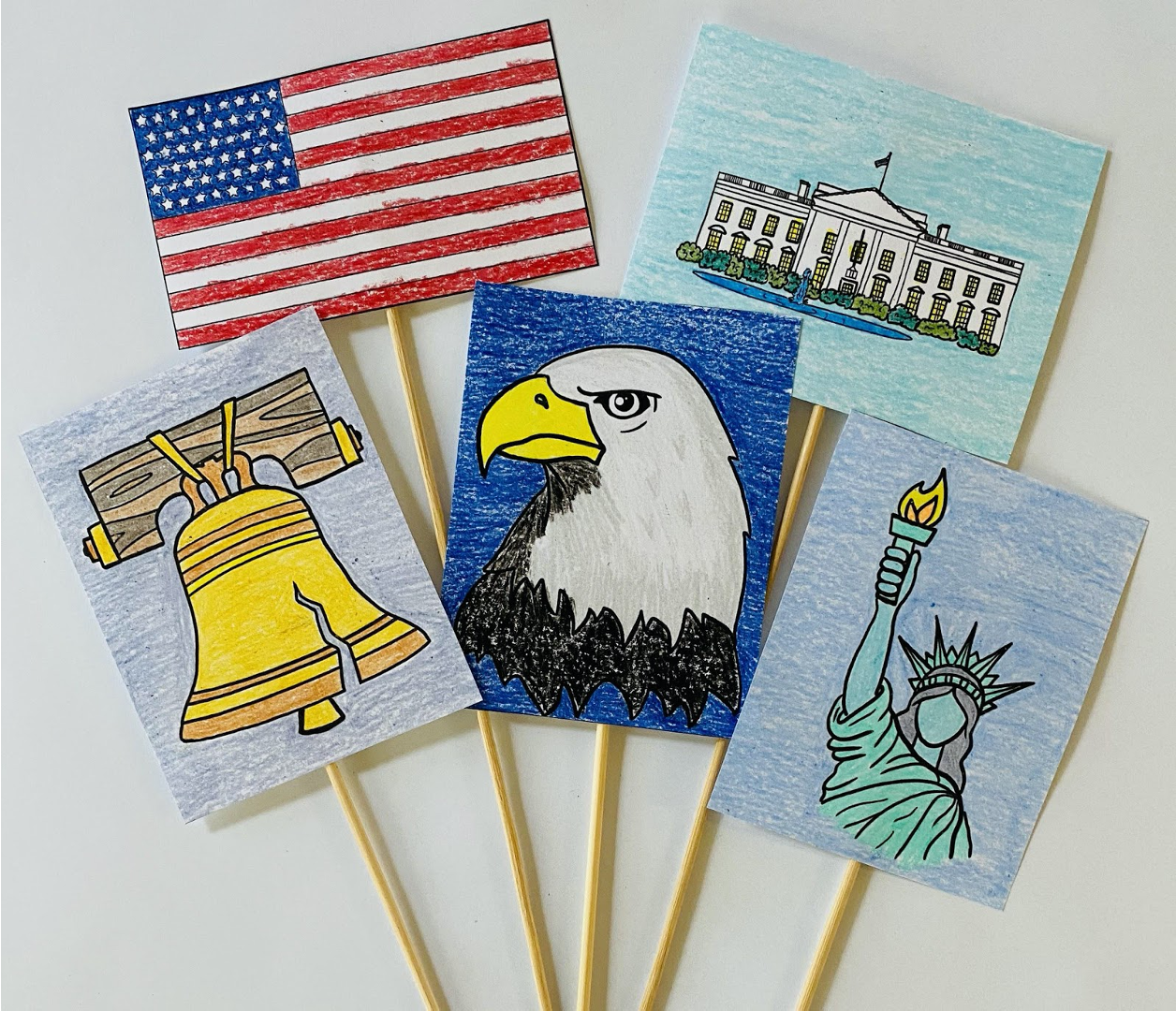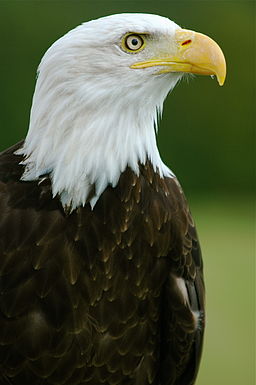Summary
In this lesson, students will learn about symbols that represent the United States, explain their importance, and demonstrate appropriate behavior when they recite the Pledge of Allegiance and when The Star-Spangled Banner is played.
Essential Question(s)
Why are symbols important?
Lesson Snapshot
Engage
Students listen to The Star-Spangled Banner and reflect on what a symbol is.
Explore
Students participate in an interactive activity to explore various symbols of the United States.
Explain
Students learn the meaning of various U.S. symbols.
Extend
Students participate in a game of Vocabulary Charades and come up with movements to help them remember the meaning of each U.S. symbol.
Evaluate
Students create symbols for their own community based on what is most important to them.
Materials List
Lesson Slides (attached)
Symbols of the United States handout (attached, one per student)
Markers, crayons, or colored pencils
Sticky notes
Popsicle sticks (five per student)
Glue
Chart paper
Engage
90 Minute(s)
Display slide 2. Define the word symbol. Explain to students that in this lesson they will learn about some important symbols related to the United States.
Display slide 3 and share the lesson's essential question: Why are symbols important?
Display slide 4 and share the lesson objectives.
Using chart paper, create a KWL Graphic Organizer. Have students volunteer what they know about symbols. Record their responses in the K column. Next, ask students what they want to know about symbols and record those responses in the W column.
Inform students that you will be revisiting the KWL Graphic Organizer at the end of the lesson. At that time, they will fill in the L column with information that they have learned.
Display slide 5. Play the U.S. national anthem, The Star-Spangled Banner, and then ask students about the song they just heard.
Do they know what the song symbolizes?
Why is it important?
How do people show respect when the Star-Spangled Banner is played?
Explore
45 Minute(s)
Display slide 7 and pass out copies of the Symbols of the United States handout and five popsicle sticks to each student. Make sure students also have access to glue and markers, crayons, or colored pencils. Have students color the images, cut them out, and then glue each one to a stick. Tell students that they will be using these images in the next activity.

Once students have finished working, share the statements below with them one at a time. After each statement, ask them to hold up the symbol that they think is being described. Feel free to share other statements that you come up with as well.
Cracked and no longer rings
Strong bird
Has 50 stars for the 50 states
Has a lot of rooms
Is in New York Harbor
Rang when leaders made laws
Stands for freedom
The president lives here
Picture on U.S. currency (money)
Has 13 stripes for the 13 colonies
Explain
45 Minute(s)
Display slide 8. Share the definition of a symbol: An object that represents something.
Have students repeat the definition aloud and then turn to the person sitting next to them. Ask pairs to take turns sharing the definition in their own words.
Display slide 9. Share the definition of a U.S. symbol: An object that represents the United States.
Have students repeat the definition aloud and then turn to the person sitting next to them. Ask pairs to take turns sharing the definition in their own words.
Create a class Anchor Chart using the symbols that you introduced in the Explore activity:
The Statue of Liberty
The White House
The Liberty Bell
Bald eagle
U.S. flag
Ask students to share what they remember about U.S. symbols from the Explore activity, and then transition into the next activity, where students will learn more about each symbol.
Go through the symbols on slides 10-14 one at a time. For each symbol, share information from a book of your choosing from your school library, or read the passage from Ben's Guide to the U.S. Government linked in the list below. Depending on the preferences and reading level of students in your class, you might read aloud to the whole class or have students read in small groups. After reading the passage, ask students to volunteer any information they might have about the symbol.
Display slide 10 and discuss the Statue of Liberty. Share the Statue of Liberty reading from Ben's Guide to the U.S. Government or another reading of your choice. After students have shared any information they know about the Statue of Liberty, share some of its history. The statue is made of copper and was presented to the people of the United States by France in 1886 as a symbol of freedom to millions of people around the world.
Display slide 11 and discuss the White House. Share the White House reading from Ben's Guide to the U.S. Government or another reading of your choice. Once students have shared any information they know about the White House, explain its importance. The White House is the official home of the president of the United States. It symbolizes democracy and human rights.
Display slide 12 and discuss the Liberty Bell. Share the Liberty Bell page from Ben's Guide to the U.S. Government or another reading of your choice. Once students have shared any information they know about the Liberty Bell, share with them its history. The Liberty Bell was made in 1752 and remains in Philadelphia, Pennsylvania near Independence Hall. It symbolizes independence.
Display slide 13 and discuss the bald eagle. Share the Bald Eagle page from Ben's Guide to the U.S. Government or another reading of your choice. Once students have shared any information they know about the bald eagle, share with them its symbolic importance. The eagle is a bird of prey found in North America. It represents freedom and all that freedom stands for. The eagle also represents honor, respect, and dignity.
Display slide 14 and discuss the U.S. flag. Share the American Flag page from Ben's Guide to the U.S. Government or another reading of your choice. Once students have shared any information they know about the flag, share with them its symbolic importance. Explain the meaning of its colors and symbols. White symbolizes purity and innocence, red symbolizes hardiness and bravery, and blue symbolizes vigilance, perseverance, and justice. Explain that the flag's stars and stripes represent the 50 states and the 13 original colonies.
Extend
45 Minute(s)
Display slide 15. Divide the class into groups of three for a game of Vocabulary Charades. Go over the two steps to follow for the Charades performances. The first step is to talk about the meaning of the symbol. The second is to create actions or movements that illustrate the symbol.
Display slide 16 to share the first symbol. Give students a few minutes to work together to prepare before having each group share their charade with the whole class. Point students to the Anchor Chart as they brainstorm to help them think about the most important information and narrow their scope. Once all groups have shared, ask someone from each group to explain how they came up with their movement. Repeat this process with the remaining symbols on slides 17-20.
After completing the charades presentations, direct students' attention to the KWL Graphic Organizer that you created earlier. Ask students to explain the importance of each symbol and any new knowledge they have gained as a note in the L column.
Evaluate
45 Minute(s)
Display slide 21. Have students retrieve their popsicle symbols. Using new information gained through the lesson's readings and the Anchor Chart, students will respond to the original statements from the Explore activity, as well as the new statements you have added. Read the statements below one at a time and ask students hold up the correct symbol for each one.
Cracked and no longer rings
Strong bird
Has 50 stars for the 50 states
Has a lot of rooms
Is in New York Harbor
Rang when leaders made laws
Stands for freedom
The president lives here
Picture on U.S. currency (money)
Has 13 stripes for the 13 colonies
To wrap up the lesson, display slide 22 and say, "Remember at the beginning when we watched The Star-Spangled Banner? Let's wrap up with the Pledge of Allegiance!" Consider sharing the Pledge of Allegiance page from Ben's Guide to the US Government. Discuss etiquette for saying the Pledge (standing, hand over heart, etc.) and end with a whole-class recitation.
Resources
Government Publishing Office. (n.d.). Ben's guide to the U.S. government. https://bensguide.gpo.gov/
K20 Center. (n.d.). Anchor chart. Strategies. https://learn.k20center.ou.edu/strategy/64f2b35101a470dda36d44421900af08
K20 Center. (n.d.). KWHL chart. Strategies. https://learn.k20center.ou.edu/strategy/d9908066f654727934df7bf4f505dd47
K20 Center. (n.d.). Vocabulary charades. Strategies. https://learn.k20center.ou.edu/strategy/b30762a7557ba0b391f207f4c600f1f0
Musicplay. (2010, September 27) Star Spangled Banner with lyrics, vocals, and beautiful photos [Video]. YouTube. https://www.youtube.com/watch?v=vPKp29Luryc


